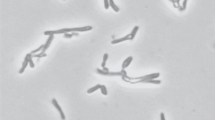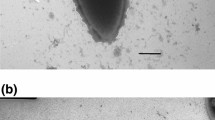Abstract
Two mixed cultures able to ferment acrylate to equimolar acetate and propionate were enriched from anaerobic sediments. From one of these mixed cultures a pure culture of a Gram-positive, obligately anaerobic bacterium was isolated. This strain, designated 19acry3 (= DSM 6251) was identified as belonging to the species Clostridium propionicum. Only a narrow range of organic compounds supported growth, including acrylate and lactate. Acrylate and lactate were fermented to acetate and propionate in a 1:2 molar ratio. When co-cultured with the non-acrylate-fermenting “Campylobacter” sp. strain 19gly1 (DSM 6222), the fermentation balance shifted to almost equimolar acetate and propionate. Strain 19acry3 was compared with Clostridium propionicum type strain X2 (DSM 1682). The two strains displayed similar phenotypic properties. The mol% G+C of DNA isolated from both strains was 36–37 (by thermal denaturation). Both strains displayed a characteristic fluorescence when observed by fluorescence microscopy. Cell-free extracts of both strains were examined by spectrophotofluorimetry. In both strains, two excitation peaks were observed at 378 and 470 nm. Excitation at either of these wavelengths resulted in an emission maximum at 511 nm.
Similar content being viewed by others
References
Cardon BP, Barker HA (1946) Two new amino-acid-fermenting bacteria, Clostridium propionicum and Diplococcus glycinophilus. J Bacteriol 52:629–634
Cardon BP, Barker HA (1947) Amino acid fermentations by Clostridium propionicum and Diplococcus glycinophilus. Arch Biochem 12:165–180
Cato EP, George WL, Finegold SM (1986) Clostridium. In: Sneath PHA, Mair NS, Sharpe ME, Holt JG (eds) Bergey's manual of systematic bacteriology, vol. 2 Williams and Wilkins, Baltimore, Maryland, pp 1141–1200
Eirich LD, Vogels GD, Wolfe RS (1979) Distribution of coenzyme F420 and properties of its hydrolytic fragments. J Bacteriol 140: 20–27
Gottschalk G (1985) Bacterial metabolism, 2nd edn. Springer, New York Berlin Heidelberg
Janssen PH (1990) Fermentation of glycollate by the mixed culture of anaerobic. Syst Appl Microbiol 13: 327–332
Janssen PH (1991) Characterization of a succinate-fermenting anaerobic bacterium isolated from a glycolate-degrading mixed culture. Arch Microbiol 155:288–293
Janssen PH, Harfoot CG (1990a) Isolation of a Citrobacter species able to grow on malonate under strictly anaerobic conditions. J Gen Microbiol 136:1037–1042
Janssen PH, Harfoot CG (1990b) Ilyobacter delafieldii sp. nov., a metabolically restricted anaerobic bacterium fermenting PHB. Arch Microbiol 154: 253–259
Kiene RP, Taylor BF (1988) Demethylation of dimethylsulfoniopropionate and production of thiols in anoxic marine sediments. Appl Environ Microbiol 54: 2208–2212
Kiene RP, Taylor BF (1989) Metabolism of acrylate and 3-mercaptopropionate. Decomposition products of (dimethyl-sulfonio)propionate in anoxic marine sediments. In: Saltzman ES, Cooper WJ (eds) Biogenic sulfur in the environment. American Chemical Society, Washington DC, pp 222–230
Pfennig N (1978) Rhodocyclus purpureus gen. nov. and sp. nov., a ring-shaped, vitamin B12-requiring member of the family Rhodospirillaceae. Int J Syst Bacteriol 28: 283–288
Shelton DR, Tiedje JM (1984) General method for determining anaerobic biodegradation potential. Appl Environ Microbiol 47: 850–857
Stouthamer AH (1979) The search for correlation between theoretical and experimental growth yields. In: Quayle JR (ed) International review of biochemistry, vol. 21 Microbial biochemistry. University Park Press, Baltimore, pp 1–47
Thauer RK, Jungermann K, Decker K (1977) Energy conservation in chemotrophic anaerobic bacteria. Bacteriol Rev 41: 100–180
Vogels GD, Keltjens JT, van derDrift C (1988) Biochemistry of methane production. In: Jehnder AJB (ed) Biology of anaerobic microorganisms. Wiley, New York, pp 707–770
Wagner C, Stadtman ER (1982) Bacterial fermentation of dimethyl-β-propiothetin. Arch Biochem Biophys 98: 331–336
Author information
Authors and Affiliations
Rights and permissions
About this article
Cite this article
Janssen, P.H. Isolation of Clostridium propionicum strain 19acry3 and further characteristics of the species. Arch. Microbiol. 155, 566–571 (1991). https://doi.org/10.1007/BF00245351
Received:
Issue Date:
DOI: https://doi.org/10.1007/BF00245351




